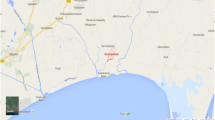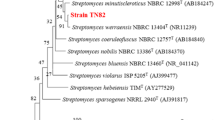Abstract
Endophytic actinomycetes encompass bacterial groups that are well known for the production of a diverse range of secondary metabolites. Vochysia divergens is a medicinal plant, common in the “Pantanal” region (Brazil) and was focus of many investigations, but never regarding its community of endophytic symbionts. During a screening program, an endophytic strain isolated from the V. divergens, was investigated for its potential to show biological activity. The strain was characterized as Microbispora sp. LGMB259 by spore morphology and molecular analyze using nucleotide sequence of the 16S rRNA gene. Strain LGMB259 was cultivated in R5A medium producing metabolites with significant antibacterial activity. The strain produced 4 chemically related β-carbolines, and 3 Indoles. Compound 1-vinyl-β-carboline-3-carboxylic acid displayed potent activity against the Gram-positive bacterial strains Micrococcus luteus NRRL B-2618 and Kocuria rosea B-1106, and was highly active against two human cancer cell lines, namely the prostate cancer cell line PC3 and the non-small-cell lung carcinoma cell line A549, with IC50 values of 9.45 and 24.67 µM, respectively. 1-Vinyl-β-carboline-3-carboxylic acid also showed moderate activity against the yeast Saccharomyces cerevisiae ATCC204508, as well as the phytopathogenic fungi Phyllosticta citricarpa LGMB06 and Colletotrichum gloeosporioides FDC83.





Similar content being viewed by others
References
Arieira J, Nunes Da Cunha C (2006) Fitossociologia de uma floresta inundável monodominante de Vochysia divergens Pohl (Vochysiaceae), no Pantanal Norte, MT, Brasil. Acta Bot Bras 20:569–580
Aroonsri A, Kitani S, Hashimoto J, Kosone I, Izumikawa M, Komatsu M, Fujita N, Takahashi Y, Shin-Ya K, Ikeda H, Nihira T (2012) Pleiotropic control of secondary metabolism and morphological development by KsbC, a butyrolactone autoregulator receptor homologue in Kitasatospora setae. Appl Environ Microbiol 78:8015–8024
Aroonsri A, Kitani S, Ikeda H, Nihira T (2012) Kitasetaline, a novel beta-carboline alkaloid from Kitasatospora setae NBRC 14216T. J Biosci Bioeng 114:56–58
Berdy J (2005) Bioactive microbial metabolites. J Antibiot 58:1–26
Bortalanza LB, Ferreira J, Hess SC, Delle Monache F, Yunes RA, Calixto JB (2002) Anti-allodynic action of the tormentic acid, a triterpene isolated from plant, against neuropathic and inflammatory persistent pain in mice. Eur J Pharmacol 453:203–208
Bracher F, Hildebrand D, Haberlein H (2004) 1-Substituted β-carboline-3-carboxylates with high affinities to the benzodiazepine recognition site. Nat Prod Res 18:391–396
De Sarro G, Carotti A, Campagna F, McKernan R, Rizzo M, Falconi U, Palluotto F, Giusti P, Rettore C, De Sarro A (2000) Benzodiazepine receptor affinities, behavioral, and anticonvulsant activity of 2aryl-2,5-dihydropyridazino[4,3-b]indol- 3(3H)-ones in mice. Pharmacol Biochem Behav 65:475–487
Eida MF, Nagaoka T, Wasaki J, Kouno K (2012) Isolation and characterization of cellulose-decomposing bacteria inhabiting Sawdust and Coffe residue composts. Microbes Environ 27:226–233
El-Deby B, Bazaid S, Gherbawy Y, Elhariry H (2012) Characterization of endophytic bacteria associated with rose plant (Rosa damascena trigintipeta) during flowering stage and their plant growth promoting traits. J Plant Interact 3:248–253
Esumi Y, Suzuki Y, Itoh Y, Uramoto M, Kimura K, Goto M, Yoshihama M, Ichikawa T (2002) Propeptin, a new inhibitor of prolyl endopeptidase produced by Microbispora II. Determination of chemical structure. J Antibiot 55:296–300
Fernández E, Weissbach U, Sánchez Reillo C, Braña AF, Méndez C, Rohr J, Salas JA (1998) Identification of two genes from Streptomyces argillaceus encoding glycosyltransferases involved in transfer of a disaccharide during biosynthesis of the antitumor drug mithramycin. J Bacteriol 180:4929–4937
Fogle MR, Douglas DR, Jumper CA, Straus DC (2007) Growth and mycotoxin production by Chaetomium globosum. Mycopathologia 164:49–56
Gamir J, Pastor V, Cerezo M, Flors V (2012) Identification of indole-3-carbolylic acid as mediator of priming against Plectosphaerella cucumerina. Plant Physiol Bioch 61:169–179
Hess SC, Brum RL, Honda NK, Cruz AB, Moretto E, Cruz RB, Messana I, Ferrari F, Cechinel-Filho V, Yunes RA (1995) Antibacterial activity and phytochemical analysis of Vochysia divergens (Vochysiaceae). J Ethnopharmacol 74:97–100
Ivanova V, Laatsch H, Kolarova M, Aleksieva K (2013) Structure elucidation of a new natural diketopiperazine from a Microbispora aerata strain isolated from Livingston Island, Antarctica. Nat Prod Res 27:164–170
Kim TU, Cho SH, Han JH, Shin YM, Lee HB, Kim SB (2012) Diversity and physiological properties of root endophytic actinobacteria in native herbaceous plants of Korea. J Microbiol 50:50–57
Kornsakulkarn J, Saepua S, Boonruangprapa T, Suphothina S, Thongpanchang C (2013) New β-carboline and indole alkaloids from Actinomycete Actinomadura sp. BCC 24717. Phytochem Lett 6:491–494
Laatsch H (2012) AntiBase. Wiley-VCH, Weinheim
Lee SO, Choi GJ, Choi YH, Jang KS, Park DJ, Kim CJ, Kim JC (2008) Isolation and characterization of endophytic actinomycetes from chinese cabbage roots as antagonists to Plasmodiophora brassicae. J Microbiol Biotech 18:1741–1746
Lin L, Xu X (2013) Indole-3-acetic acid production by endophytic Streptomyces sp. En-1 isolated from medicinal plants. Curr Microbiol 67:209–217
Meyers PR (2014) Gyrase subunit B amino acid signatures for the actinobacterial family Streptosporangiaceae. Syst App Microb 4:252–260
Patel M, Conover M, Horan A, Loebenberg D, Marquez J, Mierzwa R, Puar MS, Yarborough R, Waitz JA (1988) Sch 31828, a novel antibiotic from a Microbispora sp.: taxonomy, fermentation, isolation and biological properties. J Antibiot 41:794–797
Petrini O (1986) Taxonomy of endophytic fungi of aerial plant tissues. Microbiol 2:175–187
Price AC, Choi RJ, Health Z, Li SW, White CO (2001) Inhibition of β-ketoacyl-[acyl carrier protein] synthases by thiolactomycin and cerulenin: structure and mechanism. J Biol Chem 276:6551–6559
Ryan RP, Germaine K, Franks A, Ryan DJ, Dowling DN (2008) Bacterial endophytes: recent developments and applications. FEMS Microbiol Lett 278:1–9
Shaaban M, Schroder D, Shaaban KA, Helmke E, Grün-Wollny I, Wagner-Döbler I, Laatsch H (2007) Flazin, perlolyrin, and other β-carbolines from marine-derived Bacteria. Rev Latinoamer Quím 35:58–67
Thompson JD, Gibson TJ, Plewniak F, Jeanmougin F, Higgins DG (1997) The CLUSTAL_X Windows interface: flexible strategies for multiple sequence alignment aided by quality analysis tools. Nucleic Acids Res 25:4876–4882
Zwickl DL (2006) Ph.D. thesis, The University of Texas, Austin, US.
Acknowledgments
We thank Dr. Jack Goodman (University of Kentucky) for the HRESIMS measurements and Dr. Francisco André Ossamu Tanaka (NAP/MEPA) for the Scanning Electron Microscope analysis. D. C. S. thanks the Coordenação de Aperfeiçoamento de Pessoal de Nível Superior (CAPES) for a short-term scholarship. This work was supported in part by the University of Kentucky College of Pharmacy, the University of Kentucky Markey Cancer Center and the National Center for Advancing Translational Sciences (UL1TR000117). This work was also supported by NIH grants CA 091901 and GM 105977 to J.R., and Fundação Araucária—Apoio ao desenvolvimento científico e tecnológico do Paraná.
Author information
Authors and Affiliations
Corresponding authors
Additional information
Daiani C. Savi and Khaled A. Shaaban have contributed equally to this work.
Electronic supplementary material
Below is the link to the electronic supplementary material.
Rights and permissions
About this article
Cite this article
Savi, D.C., Shaaban, K.A., Vargas, N. et al. Microbispora sp. LGMB259 Endophytic Actinomycete Isolated from Vochysia divergens (Pantanal, Brazil) Producing β-Carbolines and Indoles with Biological Activity. Curr Microbiol 70, 345–354 (2015). https://doi.org/10.1007/s00284-014-0724-3
Received:
Accepted:
Published:
Issue Date:
DOI: https://doi.org/10.1007/s00284-014-0724-3




